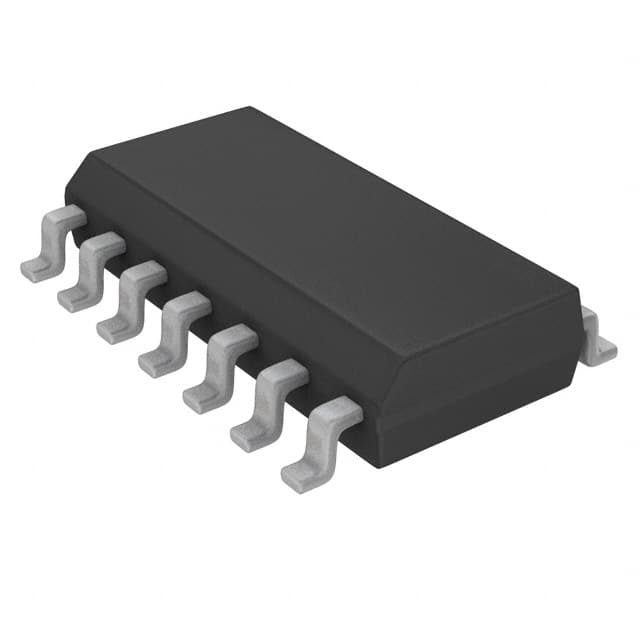Подробную информацию о продукте см. в характеристиках.

PIC16F684-I/SL
Product Overview
Category
The PIC16F684-I/SL belongs to the category of microcontrollers.
Use
This microcontroller is widely used in various electronic applications that require embedded control and processing capabilities.
Characteristics
- Low power consumption
- High performance
- Small form factor
- Wide operating voltage range
- Enhanced peripheral integration
Package
The PIC16F684-I/SL is available in a small outline integrated circuit (SOIC) package.
Essence
The essence of this microcontroller lies in its ability to provide efficient and reliable control and processing capabilities in a compact and low-power package.
Packaging/Quantity
The PIC16F684-I/SL is typically packaged in reels or tubes, with a quantity of 250 units per reel/tube.
Specifications
- Microcontroller Architecture: 8-bit
- CPU Speed: Up to 20 MHz
- Program Memory Size: 3.5 KB
- RAM Size: 128 bytes
- Number of I/O Pins: 12
- ADC Channels: 4
- Timers: 2
- Communication Interfaces: SPI, I2C, USART
Detailed Pin Configuration
The PIC16F684-I/SL has a total of 14 pins, each serving a specific purpose. The pin configuration is as follows:
- VDD - Power supply voltage input
- RA0/AN0 - Analog input or digital I/O pin
- RA1/AN1 - Analog input or digital I/O pin
- RA2/AN2 - Analog input or digital I/O pin
- RA3/AN3/VREF - Analog input or digital I/O pin, voltage reference
- RA4/T0CKI/C1OUT - Timer0 clock input or digital I/O pin, comparator output
- RA5/AN4/SS/C2OUT - Analog input or digital I/O pin, SPI slave select or comparator output
- VSS - Ground
- OSC1/CLKIN - Oscillator input
- OSC2/CLKOUT - Oscillator output
- RC0/T1OSO/T1CKI - Timer1 oscillator output or digital I/O pin
- RC1/T1OSI/CCP2 - Timer1 oscillator input or digital I/O pin, CCP2 module
- RC2/CCP1 - Capture/Compare/PWM pin
- RC3/SCL/SDA - I2C clock or digital I/O pin, I2C data or digital I/O pin
Functional Features
- Enhanced core with 49 instructions
- Flash program memory
- EEPROM data memory
- Brown-out reset (BOR)
- Power-on reset (POR)
- Watchdog timer (WDT)
- In-Circuit Serial Programming™ (ICSP™) capability
- Low voltage programming (LVP) support
Advantages and Disadvantages
Advantages
- Compact size allows for easy integration into space-constrained designs
- Low power consumption extends battery life in portable applications
- Wide operating voltage range enables compatibility with various power sources
- Enhanced peripheral integration reduces the need for external components
- In-Circuit Serial Programming™ simplifies firmware updates
Disadvantages
- Limited program memory size may restrict the complexity of applications
- Limited RAM size may impose constraints on data storage and processing capabilities
- Lack of built-in communication interfaces other than SPI, I2C, and USART may require additional components for certain applications
Working Principles
The PIC16F684-I/SL operates based on an 8-bit microcontroller architecture. It executes instructions stored in its program memory to perform various tasks. The microcontroller interacts with external devices through its I/O pins and communication interfaces. It can be programmed using In-Circuit Serial Programming™, allowing for firmware updates without the need for physical removal.
Detailed Application Field Plans
The PIC16F684-I/SL finds applications in a wide range of fields, including but not limited to: - Home automation systems - Industrial control systems - Automotive electronics - Consumer electronics - Medical devices - Internet of Things (IoT) devices
Detailed and Complete Alternative Models
Some alternative models that offer similar functionality to the PIC16F684-I/SL include: - PIC16F688-I/SL - PIC16F690-I/SL - PIC16F1823-I/SL - PIC16F1824-I/SL - PIC16F1825-I/SL
These alternative models provide comparable features and can be considered as substitutes depending on specific application requirements.
Word count: 564 words
Перечислите 10 распространенных вопросов и ответов, связанных с применением PIC16F684-I/SL в технических решениях.
What is the maximum operating frequency of PIC16F684-I/SL?
- The maximum operating frequency of PIC16F684-I/SL is 20 MHz.Can PIC16F684-I/SL be used for motor control applications?
- Yes, PIC16F684-I/SL can be used for simple motor control applications.What are the available communication interfaces on PIC16F684-I/SL?
- PIC16F684-I/SL supports USART, SPI, and I2C communication interfaces.Is it possible to use PIC16F684-I/SL in battery-powered applications?
- Yes, PIC16F684-I/SL is suitable for battery-powered applications due to its low power consumption.What programming languages are supported for PIC16F684-I/SL?
- PIC16F684-I/SL can be programmed using assembly language or high-level languages such as C.Can PIC16F684-I/SL be used in temperature sensing applications?
- Yes, PIC16F684-I/SL can be used for temperature sensing with external sensors.What are the available analog-to-digital converter (ADC) channels on PIC16F684-I/SL?
- PIC16F684-I/SL has 10-bit ADC with 12 input channels.Is PIC16F684-I/SL suitable for LED lighting control applications?
- Yes, PIC16F684-I/SL can be used for simple LED lighting control applications.Can PIC16F684-I/SL be used in automotive electronics?
- PIC16F684-I/SL is not specifically designed for automotive applications but can be used in certain automotive electronics with proper precautions.What are the available timer modules on PIC16F684-I/SL?
- PIC16F684-I/SL has multiple timer modules including Timer0, Timer1, and Timer2.

